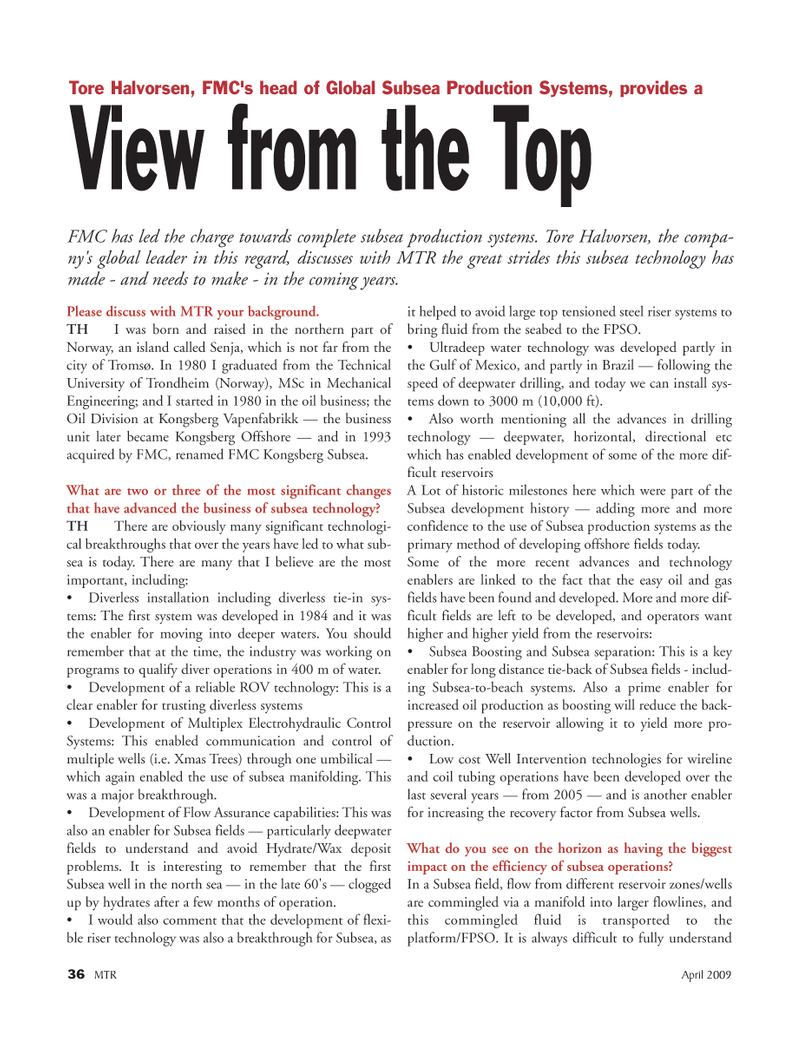
Page 36: of Marine Technology Magazine (April 2005)
Read this page in Pdf, Flash or Html5 edition of April 2005 Marine Technology Magazine
36 MTR April 2009
Please discuss with MTR your background.
TH I was born and raised in the northern part of
Norway, an island called Senja, which is not far from the city of Tromsø. In 1980 I graduated from the Technical
University of Trondheim (Norway), MSc in Mechanical
Engineering; and I started in 1980 in the oil business; the
Oil Division at Kongsberg Vapenfabrikk — the business unit later became Kongsberg Offshore — and in 1993 acquired by FMC, renamed FMC Kongsberg Subsea.
What are two or three of the most significant changes that have advanced the business of subsea technology?
TH There are obviously many significant technologi- cal breakthroughs that over the years have led to what sub- sea is today. There are many that I believe are the most important, including: Diverless installation including diverless tie-in sys- tems: The first system was developed in 1984 and it was the enabler for moving into deeper waters. You should remember that at the time, the industry was working on programs to qualify diver operations in 400 m of water. Development of a reliable ROV technology: This is a clear enabler for trusting diverless systems Development of Multiplex Electrohydraulic Control
Systems: This enabled communication and control of multiple wells (i.e. Xmas Trees) through one umbilical — which again enabled the use of subsea manifolding. This was a major breakthrough. Development of Flow Assurance capabilities: This was also an enabler for Subsea fields — particularly deepwater fields to understand and avoid Hydrate/Wax deposit problems. It is interesting to remember that the first
Subsea well in the north sea — in the late 60's — clogged up by hydrates after a few months of operation. I would also comment that the development of flexi- ble riser technology was also a breakthrough for Subsea, as it helped to avoid large top tensioned steel riser systems to bring fluid from the seabed to the FPSO. Ultradeep water technology was developed partly in the Gulf of Mexico, and partly in Brazil — following the speed of deepwater drilling, and today we can install sys- tems down to 3000 m (10,000 ft). Also worth mentioning all the advances in drilling technology — deepwater, horizontal, directional etc which has enabled development of some of the more dif- ficult reservoirs
A Lot of historic milestones here which were part of the
Subsea development history — adding more and more confidence to the use of Subsea production systems as the primary method of developing offshore fields today.
Some of the more recent advances and technology enablers are linked to the fact that the easy oil and gas fields have been found and developed. More and more dif- ficult fields are left to be developed, and operators want higher and higher yield from the reservoirs: Subsea Boosting and Subsea separation: This is a key enabler for long distance tie-back of Subsea fields - includ- ing Subsea-to-beach systems. Also a prime enabler for increased oil production as boosting will reduce the back- pressure on the reservoir allowing it to yield more pro- duction. Low cost Well Intervention technologies for wireline and coil tubing operations have been developed over the last several years — from 2005 — and is another enabler for increasing the recovery factor from Subsea wells.
What do you see on the horizon as having the biggest impact on the efficiency of subsea operations?
In a Subsea field, flow from different reservoir zones/wells are commingled via a manifold into larger flowlines, and this commingled fluid is transported to the platform/FPSO. It is always difficult to fully understand
Tore Halvorsen, FMC's head of Global Subsea Production Systems, provides a
View from the Top
FMC has led the charge towards complete subsea production systems. Tore Halvorsen, the compa- ny's global leader in this regard, discusses with MTR the great strides this subsea technology has made - and needs to make - in the coming years.
MTR#3 (34-49).qxd 4/6/2009 9:05 AM Page 36

 35
35

 37
37
